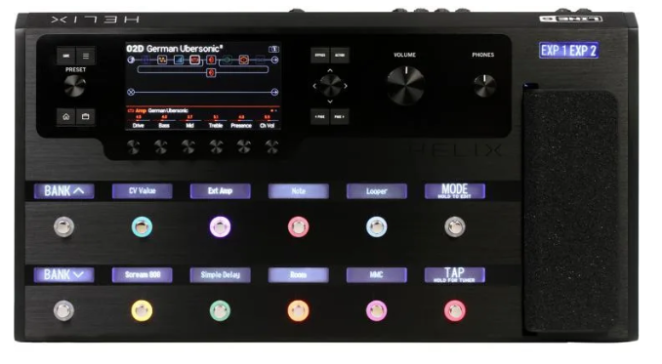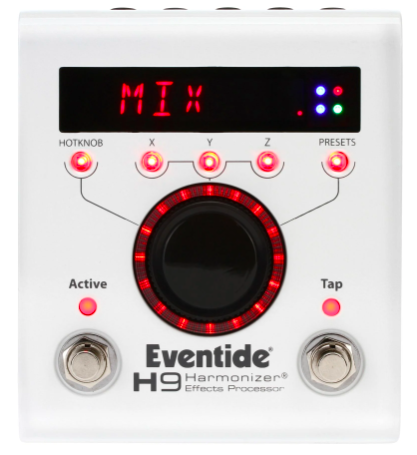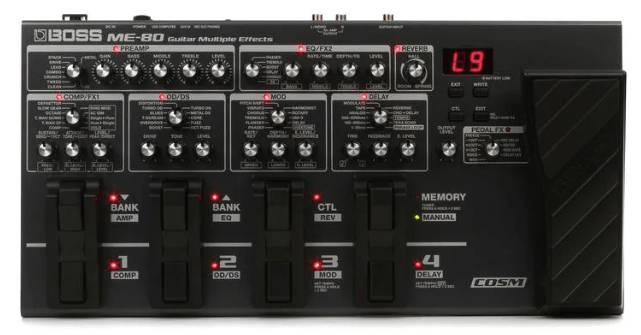When you buy through our links, we may earn an affiliate commission.
Do you want access to a range of effects without splashing out on multiple stompboxes? If so, a multi-effects pedal could be the perfect solution.
These devices allow you to use effects from the gain, modulation, timing, and dynamic categories without cluttering up your pedalboard.
Our top recommendation is the outstanding Line 6 Helix Floor Processor. This device offers a comprehensive variety of effects, providing almost endless possibilities for guitarists.
In this guide, we’ll present you with the best multi-effects pedals available. We’ve included options that cater to all musical styles and budgets so that you can find the right option.
Quick Summary of the Best Multi-Effects Pedals
- Line 6 Helix Multi-effects Floor Processor (Best Overall)
- Eventide H9 Max Multi-effects Pedal (Best Compact Pedal)
- Boss ME-80 Guitar Multi-effects Pedal (Best Budget Multi-Effects Pedal)
- Boss GT-1B Bass Multi-effects Processor (Best Bass Multi-Effects Pedal)
Best Multi-Effects Pedals
1. Best Overall – Line 6 Helix Multi-effects Floor Processor

SPECS
- Number of Effects: 200+
- Presets: 1024
- Amp Modeling: Over 100 Cab, Amp and Mic Models
- Expression Pedal: Built-in
It’s difficult to definitively say which multi-effects guitar pedal is the most powerful ever, but the Line 6 Helix is certainly a contender for this title. Every time I start using this pedal, I find it very difficult to leave it alone.
This processor is designed to be used on the floor, like having an entire DAW’s effects rack on your pedalboard. It houses a huge selection of over 200 ready-to-use effects and over 100 amp, cab, and mic models.
One of the features I really enjoy when using this pedal with my electric guitar is the looper, which is great for jamming alone or playing solo performances. Furthermore, the inclusion of a built-in expression allows you to adjust the parameters of the selected effects with ease. Some argue that standalone expression pedals are more effective and reliable than built-in ones.
If I were to describe all of the capabilities of this pedal, it would take up hours of your time. It’s a rare type of pedal with no weak areas and delivers both quality and quantity; for that, Line 6 deserves a lot of credit.
What we like about it:
- This pedal includes a wide range of HX effects and amp models to suit every style of guitar playing.
- It produces flawless sound quality thanks to its excellent digital processing.
- There are hundreds of slots to save your custom presets for easy recall.
What we didn’t like about it:
- The capabilities of this pedal make it one of the more complicated devices to operate, especially for those who are new to HX effects.
2. Best Compact Pedal – Eventide H9 Max Multi-effects Pedal

SPECS
- Number of Effects: 52 (500+ downloadable presets)
- Presets: 99
- Amp Modeling: N/A
- Expression Pedal: Input for External Pedal
The Eventide H9 is a remarkably versatile pedal considering its extremely compact size. The layout and design of this device are slightly misleading, as it looks rather basic at first glance, but once you start to experiment with the controls, its capabilities become apparent.
The main thing that drew me to this pedal initially was that it comes with 99 pre-installed sounds, but by connecting it to the H9 Control app, you get access to over 500 more!
In addition to this incredibly vast range of presets, the H9 comes equipped with 52 high-quality algorithms. Every effect that is included on the brand’s revered stompboxes has been added to this pedal - which makes it great value.
With a built-in tuner, this pedal is the perfect device for a guitarist who wants to access all of the effects and tools they could need on stage or when recording - while taking up hardly any space!
What we like about it:
- A compact solution, the H9 is a practical and highly versatile addition to a guitarist’s signal chain.
- You can choose from an extensive selection of effect presets to suit your style of playing.
- The control layout is minimalistic and straightforward to operate.
What we didn’t like about it:
- You need to connect the pedal to the H9 Control app in order to access all of its features and capabilities.
3. Best Budget Multi-Effects Pedal – Boss ME-80 Guitar Multi-effects Pedal

SPECS
- Number of Effects: 59
- Presets: 36
- Amp Modeling: COSM Amp Models
- Expression Pedal: Built-in
In my experience, affordable multi-effect guitar pedals can be hit and miss. It’s often worth spending extra to ensure that the device produces high-quality effects, but this Boss ME-80 is exceptional despite its modest price tag.
I was looking forward to checking this pedal out after learning that it was largely based on the design of the popular GT-100 and Boss’ other multi-dimensional processing devices, and it didn’t disappoint. One thing I miss, though, is the features of Boss EV-30 expression pedal with dual inputs.
With a COSM preamp section, as soon as you connect a power supply, you are in complete control of the pedal's sound and can sculpt amplifier tones that sound much more realistic than most digital amp modeler simulations.
Then, using the eight footswitches, it’s easy to flick through the various effects, which include delay, distortion, and various forms of modulation.
If you’re looking for m multi-effects processor that can take your guitar recordings to the next level, the Boss ME-80 is a great option. It features an unbuilt USB audio interface, so you can plug it straight into Pro Tools, Logic Pro, Ableton Live, or whichever DAW you use.
What we like about it:
- This device includes every type of effect an electric guitarist could need in their entire rig.
- The ME-80 is an excellent tool for recording directly into your chosen DAW.
- With a wide range of modeling presets you can access many classic tube-driven and solid-state amp sounds.
What we didn’t like about it:
- The pedal has lots of knobs which can be tricky to adjust when you’re performing.
4. Best Bass Multi-Effects Pedal – Boss GT-1B Bass Multi-effects Processor

SPECS
- Number of Effects: 90
- Presets: 99
- Amp Modeling: Preamp Models
- Expression Pedal: Built-in
Multi-effect pedals are not exclusive to guitarists - as this GT-1B processor, which is made especially for bass, proves. Although it’s a similar price, it doesn’t bear many physical similarities to the ME-80 pedal, but it shares the durability and sound quality we expect from Boss devices.
I’ve used many bass effects pedals in the past, and one of the areas they frequently fall short of is preventing noise issues. The GT-1B impressed me with its ability to produce extreme effects like distortion and bass synth without any unwanted noise.
The onboard rocker plate pedal can be used for effects like wah, or to control a specific aspect of the sound as you play. It’s also really easy to create your custom preset mode and save them to one of the 99 blank user slots.
In addition to the more transformative bass sounds that this pedal houses, such as chorus, delay, and distortion effects, you also gain access to tools like a defretter and EQ to improve the overall sound of your instrument when performing live or recording.
What we like about it:
- This pedal includes a range of bass effects and amp models that cater to all playing styles and musical genres.
- The multi-dimensional processing ensures exceptional sound quality and no noise issues.
- By using effects like the bass synth, wah, and EQ, you can make your bass sound otherworldly!
What we didn’t like about it:
- There is no MIDI connectivity.
Best Multi-Effects Pedals Buyer's Guide
In this section, we'll guide you through essential factors you should know when purchasing a multi-effects pedal.
We cover important topics like the range of effects, ease of use, versatility, build quality, and effect types to help you pick the perfect pedal to elevate your guitar-playing experience.
Range of effects
The best multi-effects pedals are designed for one main purpose - to provide musicians with a wide range of guitar effects in a single enclosure. Some are designed to include a range of effects from different categories, such as modulation, dynamics, and gain-based effects. Others focus more on a specific effect category and are suited to certain styles or purposes.
Ease of use
A multi-effect unit's user interface and layout significantly impact how easy it is to operate. Ideally, you want to choose a pedal suitable for your level of knowledge and your willingness to put up with potentially complicated designs to fine-tune the sound to your liking.
Versatility
The best multi-effect units are likely to include user preset slots, and ready-made presets so that you can use them to access an array of sounds whenever you need them. It should also offer versatile connectivity so you can use it with other devices in your signal chain or connect expression pedals. Amp models and cabinet simulations are also worth looking out for, as they can expand the capabilities of the device.
Build Quality
It’s likely that you’ll be tweaking the settings on your multi-effect pedal regularly to create your desired sounds. Therefore, it must be durable enough to withstand heavy usage, particularly if you regularly play live shows or use your effects pedals to practice alone or with your band.
Effect Types and Quality
Arguably the two most important things that you need to assess when choosing a multi-effects pedal are the type of digital effects it can produce and their quality.
It’s easy to fall into the trap of assuming that the more effects the pedal is capable of producing, the better it will be. However, even if it has all the processing power in the world if the quality of the effects is lacking, the quantity becomes less important.
The common effects categories you’ll find on most multi-effects units are:
- Gain (overdrive, distortion, etc.)
- Modulation (chorus, flanger, phaser, etc.)
- Timing (reverb, delay)
- Filter (wah, envelope)
- Dynamics (compressors, limiters, etc.)
- Amp modeling features
A high-end multi-effects unit like the Line 6 Helix Floor Processor we featured in this guide covers all the above effects, and amp simulation, without compromising on quality. Others, like the Boss GT-1B, are designed specifically for a certain purpose, in this case, bass effects, and therefore are more limited.
I’d recommend thinking carefully about the effect types that you need, and then checking that the pedal you’re considering includes them. You may already have certain pedals in your signal path, and therefore, not require them from a multi-effects device. For example, if you already have one of the best flanger pedals you could find, no need to go for the one in a multi-effect pedal.
Connectivity and Compatibility
Connectivity is important with all effects pedals, but it’s particularly integral to the functionality of the best multi-effects pedal devices. Due to the versatile nature of these pedals, manufacturers often install several inputs and outputs so that they can be easily integrated with other devices.
The most basic multi-effects units will likely include at least one 1/4-inch guitar input and outputs. However, more advanced devices often boast USB connectivity, compatibility with external pedals, MIDI connectivity, and potentially more.
The more inputs and outputs you have to work with, the more external devices your multi-effects unit will be compatible with. You can connect it to a USB audio interface for direct recording, connect it to a PA system for live performances, or link it to software on a computer to further expand its capabilities.
USB connectivity is included on some of the best multi-effects pedals, allowing you to update the firmware and potentially download presets and models onto the pedal from the manufacturer’s website.
Modeling and User Presets
Multi-effects units often use digital modeling to recreate the sound of analog effects or sounds. A common feature of the pedals designed for electric guitars is amp and cabinet simulations, which can be very useful when recording.
By using amp and cabinet models, you can access classic amp tones without needing to buy them. While the sounds aren’t always totally accurate, some are so good that it’s hard to tell them apart from the real amps.
Manufacturers also commonly use modeling to recreate the sound of classic effects hardware and analog pedals. This is a cost-effective way to get high-quality sounds on your pedalboard. For an authentic sound, standalones like tape echo pedals and others, are a better although a more expensive option.
Another thing that the best multi-effects pedals all have in common is that they allow you to save any sounds to user-preset slots. This is useful if you like to customize and shape the effects to suit your style.
If you enjoy experimenting with controls and settings, make sure you choose a pedal like the Boss ME-20, which includes 36 user preset slots for saving your favorite sounds.
Frequently Asked Questions (FAQs)
Can you use multi-effects pedals with other pedals in a signal chain?
It’s a common misconception that when you acquire a multi-effects device, you no longer need to use your existing effects pedals. In reality, using them in combination with each other can produce the best results for some people.
It comes down to two things: firstly, whether your multi-effects pedal can produce the same effects that your individual pedals do, and secondly, whether it does this better.
If you really like the reverb effect that your multi-effects pedal produces, you can probably consider removing your old reverb pedal from your signal chain, but if you prefer your chorus pedal to the chorus effect on the multi-effects unit, you can use them together.
How can I optimize the signal chain order within my multi-effects pedal to achieve the best possible sound?
There is a lot of debate around where the best multi-effect pedal location in your signal chain is, but ultimately it depends on what other pedals you are using and what sound you are aiming for, and whether you're using an FX loop.
It’s advisable to place a multi-effects pedal close to the end of your signal chain, but if you’re using reverb and delay, you should consider positioning it before them to avoid the sound getting too chaotic.
Do multi-effects pedals commonly have latency issues?
Latency is an issue that can plague music producers when they’re trying to use VST plugin effects. It was also common with many early guitar multi-effects processors.
Modern multi-effects pedals usually have powerful digital processors, allowing them to work without noticeable latency issues. The technology behind digital signal processing is very sophisticated and reliable, so there shouldn’t be a lag when using this type of pedal.
Closing Thoughts
Now that you’ve read our detailed guide on the best multi-effects pedals, you should have a clear idea of which model is best suited to your specific needs. Each of the pedals we included has distinct qualities that make them ideal for certain purposes.
The main things to keep in mind when looking for the best multi-effect pedal, are the quality of the sound, the number of effects it can produce, and the usability of its controls.
Our top recommendation is the Line 6 Helix Floor Processor, which is arguably the most comprehensive and advanced multi-effects pedal ever made.
Alternatively, if you’re looking for an affordable option, the Boss ME-80 is worth considering.
Photo Courtesy Sweetwater

